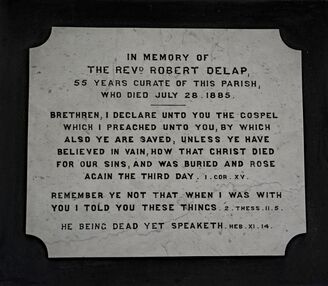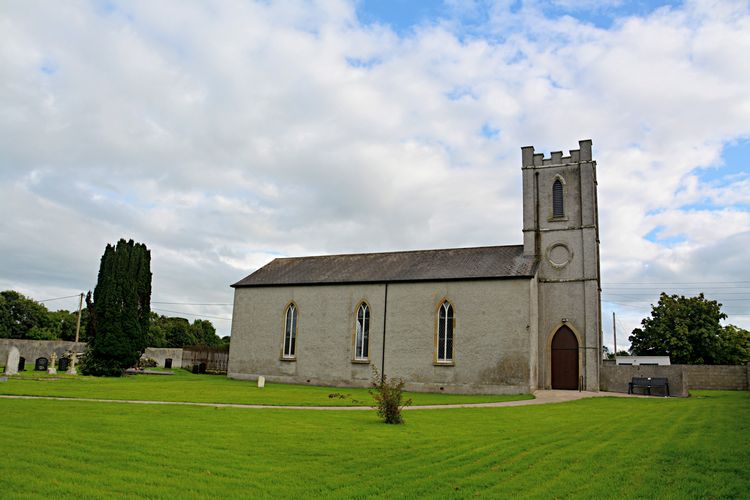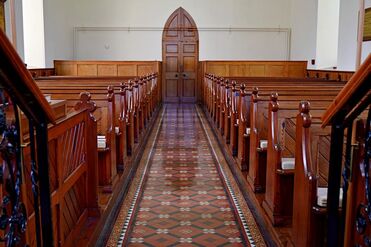ST. ANNE'S (C.o.I.), Monellan, The Cross, Killygordon
Built 1833
St. Anne's at The Cross, Killygordon, was built as a chapel of ease to St. Patrick's, Castlefinn. A chepel of ease is a consecrated building within a parish but not the main church of that parish. They were built to make religious attendance more accessible to those who may not be able to travel to the main church of their parish. Remember, back when they were built very few people would have had any sort of transport to travel a distance, hence there being a number of such buildings dotted around County Donegal (and obviously further afield).
REV. ROBERT DELAP
 Memorial to Reverend Robert Delap inside the church
Memorial to Reverend Robert Delap inside the church
Robert Delap (1802-1885) was the first Minsiter of St. Anne's Church and was the person who had the church built in 1833.
He inititally trained as a barrister, one of his contemporaries at college being Daniel O'Connell ('The Liberator'), before, later becoming a Minister.
He is buried in the grounds of St. Anne's (see photographs below). He and his wife, Isabella, had three children. In St. Anne's graveyard Robert and Isabella's burial plot is surrounded by a rough stone wall which is almost identical to the burial plot and walls around it, at the cemetery in the grounds of the nearby estate the family once owned, Monellan. In that plot both his son and his daughter are buried, at their request, along with a friend and it is believe, their dogs.
He inititally trained as a barrister, one of his contemporaries at college being Daniel O'Connell ('The Liberator'), before, later becoming a Minister.
He is buried in the grounds of St. Anne's (see photographs below). He and his wife, Isabella, had three children. In St. Anne's graveyard Robert and Isabella's burial plot is surrounded by a rough stone wall which is almost identical to the burial plot and walls around it, at the cemetery in the grounds of the nearby estate the family once owned, Monellan. In that plot both his son and his daughter are buried, at their request, along with a friend and it is believe, their dogs.
Click on any of the photographs below to enlarge.
REV. SAMUEL DELAP
|
Rev. Samuel Francis Delap (1776 or 1777 - 1849) was the father of the above named Robert.
It is said he is buried under the aisle of St. Anne's and quite unusually for Donegal, he is buried standing up. Apparently they placed a slab on top of his upright coffin to support the aisle but it had to be repaired several times because of subsidance as the coffin deteriorated. |
About St. Anne's Church from Buildings of Ireland:
"This plain but appealing early nineteenth-century Church of Ireland church retains its early form and character, despite some alterations. It also retains much of its early fabric including quarry-glazed windows, while the pointed-arch openings lend this building a muted Gothic theme that is typical of its type and date.
The layout of this church is typical of the standard three-bay hall and tower church, which were built in large numbers, particularly between 1808 - 1830, using loans and grants from the Board of First Fruits (1722 - 1833). The plain exterior elevations are enlivened by the simple ashlar sandstone surrounds to the openings, while the plain stringcourses to the tower add some additional muted decorative interest. The blind round opening over the doorway was probably formerly a clockface.
The interior also survives intact with some interesting carved timber features, a number of wall memorials including one commemorating those members of the parish that died during World War 1, and an attractive and attractive encaustic tiled floor, adding interest. Lewis (1837) records that this church was built in 1833 as a chapel of ease associated with St. Patrick’s Church of Ireland church, which is located just outside nearby Castlefinn. The Ordnance Survey Memoirs for the area records that ‘a chapel of ease at the crossroads above Killygordon which has been lately erected by the Board of First Fruits…
The churchyard has been very tastefully laid out and planted by the curate Revd Robert Delap'. The graveyard contains a collection of mainly upstanding gravemarkers, some of which are of modest artistic merit, and a number with wrought-iron and\or cast-iron railed enclosures that add some additional interest. Located to the centre of the small village of Crossroads, and to the south-west of Killygordon, this church is an interesting addition to the built heritage and social history of the local area."
JAMES HEWITT, 4th VISCOUNT LIFFORD
James Hewiit is buried in the grounds of the church in a large plot surrounded by high railings, at the far end of the church.
From Wikitree:
“James Hewitt, 4th Viscount Lifford, was born on 31 March 1811 at Merrion Square, Dublin, County Dublin, Ireland. He was the son of James Hewitt, 3rd Viscount Lifford and Hon. Mary (Maude) Hewitt.
He was educated at Christ Church, Oxford University, Oxford, Oxfordshire, England. He held the office of Sheriff of County Donegal in 1841. He wrote the book Ireland and the Irish Church, published 1842. He wrote the book Thoughts on the Present State of Ireland, published 1849. He held the office of Deputy Lieutenant (D.L.) of County Donegal. He succeeded as the 4th Viscount Lifford, County, Donegal [I., 1781] on 22 April 1855. He succeeded as the 4th Baron Lifford of Lifford, County Donegal [I., 1768] on 22 April 1855.3 He held the office of Representative Peer [Ireland] between 1856 and 1887. He wrote the book A Plea for Irish Landlords, published 1867.
He married, firstly, Lady Mary Acheson, daughter of Archibald Acheson, 2nd Earl of Gosford and Mary Sparrow, on 9 July 1835. He married, secondly, Lydia Lucy Wingfield Digby, daughter of Reverend John Digby Wingfield Digby and Anne Eliza Smith, on 9 December 1851.
He died on 20 November 1887 at age 76 at Meen Glas Halt, County Donegal, Ireland.”
NOTE: Only his first wife is mentioned on his gravestone (see below).
Click on any of the photographs to enlarge.
From Wikitree:
“James Hewitt, 4th Viscount Lifford, was born on 31 March 1811 at Merrion Square, Dublin, County Dublin, Ireland. He was the son of James Hewitt, 3rd Viscount Lifford and Hon. Mary (Maude) Hewitt.
He was educated at Christ Church, Oxford University, Oxford, Oxfordshire, England. He held the office of Sheriff of County Donegal in 1841. He wrote the book Ireland and the Irish Church, published 1842. He wrote the book Thoughts on the Present State of Ireland, published 1849. He held the office of Deputy Lieutenant (D.L.) of County Donegal. He succeeded as the 4th Viscount Lifford, County, Donegal [I., 1781] on 22 April 1855. He succeeded as the 4th Baron Lifford of Lifford, County Donegal [I., 1768] on 22 April 1855.3 He held the office of Representative Peer [Ireland] between 1856 and 1887. He wrote the book A Plea for Irish Landlords, published 1867.
He married, firstly, Lady Mary Acheson, daughter of Archibald Acheson, 2nd Earl of Gosford and Mary Sparrow, on 9 July 1835. He married, secondly, Lydia Lucy Wingfield Digby, daughter of Reverend John Digby Wingfield Digby and Anne Eliza Smith, on 9 December 1851.
He died on 20 November 1887 at age 76 at Meen Glas Halt, County Donegal, Ireland.”
NOTE: Only his first wife is mentioned on his gravestone (see below).
Click on any of the photographs to enlarge.



































